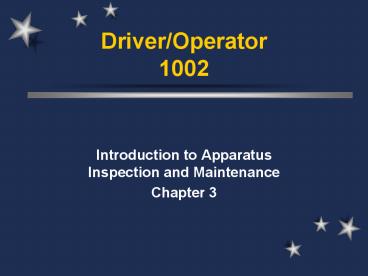Driver/Operator 1002 - PowerPoint PPT Presentation
1 / 28
Title:
Driver/Operator 1002
Description:
Driver/Operator 1002 Introduction to Apparatus Inspection and Maintenance Chapter 3 Job Performance Requirements NFPA 1002 2-2.1 Perform routine tests, inspections ... – PowerPoint PPT presentation
Number of Views:848
Avg rating:3.0/5.0
Title: Driver/Operator 1002
1
Driver/Operator1002
- Introduction to Apparatus Inspection and
Maintenance - Chapter 3
2
Job Performance RequirementsNFPA 1002
- 2-2.1 Perform routine tests, inspections, and
servicing functions on the systems and components
specified , given a fire department vehicle and
its manufacturer's specifications so that the
operational status of the vehicle is verified.
3
- Battery(ies)
- Braking System
- Coolant System
- Electrical System
- Fuel
- Hydraulic Fluids
- Oil
- Tires
- Steering system
- Belts
- Tools, appliances, and equipment
4
- 2-2.2 Document the routine tests, inspections,
and servicing functions, given maintenance and
inspection forms, so that all items are checked
for proper operation and deficiencies are reported
5
- 3-1.2 Perform the specified routine tests,
inspections, and servicing functions specified in
the following list, in addition to those
contained in 2-2.1, given a fire department
pumper and its manufacturers specifications, so
that the operational status of the pumper is
verified
6
Driver/Operator
- Are most often times responsible for upkeep
readiness of the apparatus and reporting and
recording in-service inspections
7
- Maintenance- Keeping the apparatus in a stage of
usefulness or readiness - Repair- repair or restore that which has become
inoperable. - Preventive Maintenance- ensures the reliability,
reduces the frequency cost of repairs, and
out-of-service time.
8
A Systematic Maintenance Program
- May be the responsibility of supervised
maintenance shops or the Driver/Operator
9
How is record keeping important?
- It shows that maintenance has been performed
- Records may be scrutinized by investigators
- Documentation can help decide on new purchases of
vehicles
10
Shop records should include
- Shop check-ups
- Major and miner repairs
- Parts replacement
11
Cleanliness
- A Clean Apparatus permits
- Permits proper inspection
- Permits functional parts
- Promotes good public relations
12
Washing
- Use garden hose without nozzle
- Do not dry rub
- Use good automotive shampoo
- Avoid extremely hot water or hot surface
- Rinse loose dirt before shampooing
- Wash grime, bugs, grease before it dries
- Never use gasoline or other solvents
- Use a chamois for drying
13
Glass Care
- Use warm soapy water or commercial cleaners
- Do not use dry towels or rags by themselves
- Avoid use of putty knives, razors, steel wool to
remove deposits
14
Interior Cleaning
- Check manufacturer specifications for use of
cleaning materials. - Many newer apparatus are not required to be
waxed.
15
Waxing
- If required, should be applied after six months
old.
16
Apparatus Inspection Procedures
- Systematic procedure
- Ensures all items are checked
- Performed career personnel beginning each shift,
volunteer personnel weekly or biweekly.
17
Approaching the Vehicle
- Inspection actually begins here
- Look for leakage of fluids( oil,transmission,
etc)
18
Left and Front Side Inspection
- Make general observance
- Check door for problems
- Check tire condition
- Proper inflation-- too much or too little air
pressure - Valve stem-- cuts, cracks or loose
- Tire condition-- proper type, tread depth,
separation
19
Front Inspection
- Look for missing, damaged, worn parts
- Some air systems storage tanks require drainage
- Check windshield
- Check condition of all lights
- DO NOT CHECK AUDIBLE WARNING DEVICES with someone
standing in front of vehicle
20
Front Inspection
- If equipment is stowed on the front, it should be
checked - Pump intakes
- Pump discharge
- Winches
- Hydraulic rescue tool systems
21
Left and Right Rear Inspection
- Check the condition of the chassis
- Check splash guards
- Check equipment (exterior interior)
- Visually check water level
- Inspect hose lays
22
Rear Inspection
- Inspect lights
- Check exterior equipment
- Check hose loads
23
In-Cab Inspection
- Adjust mirrors
- Avoid running under full load until engine is
warmed - Check guages
- Steering should have proper adjustment
- 10 degrees in either direction
- Perform brake test
- Should operate within 60 seconds of starting (air
brakes)
24
Engine Compartment Inspection
- Engine oil
- Engine air filter
- Emergency shutdown (if applicable)
- Exhaust
- Radiator coolant
- Windsheild washer
- Battery condition
- Lubrication
25
Post trip Inspection
- May be abbreviated pre-trip inspection
26
Charging Batteries
- Make sure battery ignition switches are off
- Identify polarity
- Attach red with red/ black with black
- Connect to a reliable power source
- Set the desired voltage charging rate
- To disconect, follow reverse steps
27
General Fire Suppression Equipment (Daily)
- Put pump in gear
- Check auxiliary fuel tanks
- Check gauges on pump panel
- Drain fire pump and booster lines (cold)
- Check Water and foam tanks
- Check for water leaks in compartments
28
General Fire Suppression Equipment (Weekly)
- Flush the pump
- Check and clean intake strainers
- Check pump gear for proper oil level
- Operate primer with all vales closed
- Operate changeover valve
- Check packing glands
- Recalibrate flow meter if applicable
- Operate pump































